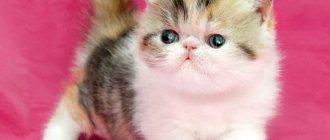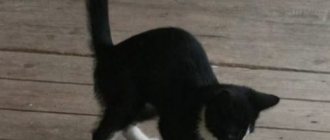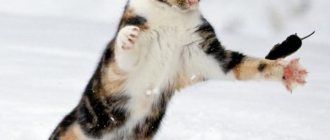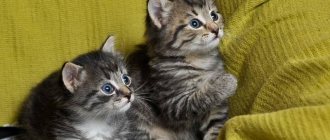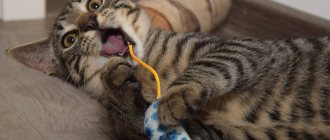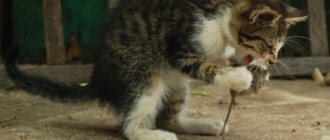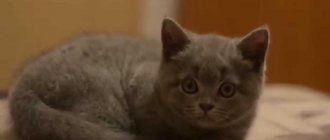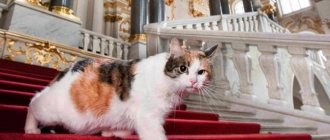Agility of Scottish Folds
Experts have repeatedly emphasized that a cat’s innate dexterity requires constant training. Active games, walks, and arrangement of all kinds of areas with ladders, masts, high and low posts are designed for this. This way the pet will learn to control its body, balance correctly, maintain balance in the most inconvenient positions, and navigate the length and height of jumps. If Scottish Fold kittens can catch a feather in childhood, it means that a mouse will not escape them in adulthood.
Which cat is suitable for catching rodents?
The first conclusions about the adaptability of animals to hunting can be drawn from their behavior in childhood. If the baby is active, shows persistence in games, moves a lot, runs and is not afraid to jump - this indicates good health. Such a cat, when he grows up, can easily catch a mouse. Later, the pet demonstrates tracking and stalking skills. He freezes in the shelter, squats springily, shows signs of excitement - he moves his ears, raises the fur on his spine, hits the surface with his tail, and quickly attacks. This indicates that the Scottish Fold cat will catch mice. If, by the time the animal reaches the age of puberty, it has not acquired the listed skills, its hunting qualities will no longer appear.
The Scottish cat is an excellent choice for keeping within a private home. Most likely, she will catch mice, but not as skillfully as an ordinary yard cat does. For her, this is entertainment, not hunting. Therefore, cat prey often ends up at the feet of the owner - this is how the pet demonstrates its devotion to the person.
Source
Care and maintenance of Scottish straight-eared cats
Caring for straights is easy. Once a week you need to comb the coat with a special comb to remove dead hair. The Scottish Longhair cat requires more careful care of its coat, so it needs to be brushed more often.
Necessary hygiene procedures include: wiping eyes, cleaning ears, teeth, trimming nails with tweezers or scissors. Bathing the pet is carried out as needed using cat shampoos.
It is necessary to regularly visit the veterinarian, carry out vaccinations and deworming.
Regarding the question of what to feed a Scottish Straight cat, veterinarians are unanimous on this issue: Scottish Straight cats have some special features of the digestive system, so feeding should be approached responsibly.
If natural food is a priority, then the pet’s diet should be enriched with proteins, vitamins and macroelements. The menu to feed the kitten should contain lean meat, offal, marine fish, fermented milk products (except milk), cereals, and vegetables.
Products containing large amounts of sugar, fat, and salt are prohibited, as they contribute to weight gain, decreased mobility and activity. The main requirement for a natural diet is that the daily dose of food must contain the required amount of calcium.
Food from your table is strictly contraindicated for your pet. Sausages, sausages, and semi-finished products can be dangerous to the health of the animal.
If you decide to feed your Scottish kitten with ready-made industrial food, then you should give preference to super premium products.
Scottish Fold
These beautiful cats are very beautiful, with an ash color and short, flat ears. However, no matter how sad it may sound, these animals are completely unsuited to catching mice.
And the point is not that they are lazy, they just have a very poorly developed hunter instinct . The Scottish Fold is not a cheap breed, and wealthy people can afford it. And it’s unlikely that they buy a cat for a lot of money purely for catching. She is treated like a member of the family.
The question of whether cats catch mice better than cats does not apply to Scottish Folds either. They are equally unwilling to do this, and rarely can this breed afford to get up from its bed and go hunting.
Scottish Fold cats don't like to catch mice.
Character and behavior of lop-eared animals
British seals are also instinctual predators, but they lack a sense of aggression. They easily catch prey, but often simply release it.
The Scotsman is a purebred cat that is distinguished by its kind disposition. Distinctive behavioral traits:
- communication skills and sociability;
- love for children;
- gaiety;
- easy to educate with the right and friendly approach;
- actually cannot be trained;
- playful;
- not mischievous;
- they quickly forget bad things and do not take revenge.
Scottish Folds are an ideal option when there are other animals and children in the house. Such kittens are real aristocrats with their mannerisms and waywardness. Their restiveness and capriciousness are often observed. If the Scots want something, they will definitely achieve it. An adventurous breed with a curiosity for the unknown. When new people appear on their territory, Scottish cats are not very friendly, but then they begin to communicate. Scots love to play, but are not particularly happy with cuddling and cuddling.
Do Scottish cats catch mice? Do Scottish cats catch mice?
Scottish Fold. Myths and reality of cats with flattened ears
Scottish Fold is one of the most discussed breeds, causing many conflicting opinions and heated debates. There are breeders who successfully work with it and do not know any problems, and there are felinologists who consider this breed almost genetic garbage and write about endless diseases to which, in their opinion, folds are susceptible. Some felinological systems accept the “Scots” with open arms, while others are categorically against folds and at each General Assembly they postpone the decision on their registration indefinitely. Some, based on Scottish Folds, create such outlandish breeds as the Ukrainian Levkoy, while others, to put it mildly, do not like Folds for their success and are afraid that the demand for kittens of similar straight-eared breeds may soon fall due to fold-eared competitors. The Scottish breed literally drowned in disputes and disagreements. It is already difficult to distinguish myths from truth. Therefore, I want to figure out who the Scottish really are and do they have dark secrets?
Behavior change
There are often cases when cats behave quite aggressively towards household members and guests. Pets are capable of not only scratching furniture, but also attacking. The animal experiences a kind of stress (usually due to dissatisfaction). This behavior goes from episodic to permanent status, since the pet considers it the norm.
The problem can be solved if the animal is sterilized in a timely manner. The cat becomes more accommodating because the source of “indignation” ceases to be relevant. If even several months after the operation the cat still continues to be mischievous, then the cause should be sought in other factors (constant stress, illness, lack of attention, etc.). In the first days after the operation, the animal may behave too calmly. It will seem that in such a short period of time the pet's activity will decrease significantly. But actually it is not. The rehabilitation period for each individual is different. For some, a couple of days are enough to recover, while for others it takes up to several weeks or even months.
Russian blue cats
These beautiful cats with soft, thick gray fur with blue tints have won the hearts of many people not only with their beauty, but also with their ability to catch mice.
Russian blue cats are strong, hardy, ready to attack even large rodents, not to mention ordinary mice, which, having smelled the scent of a predator, try with all their might to avoid meeting it. Sometimes even big rats are afraid to come out of their holes, so as not to run into this beautiful huntress.
Unlike their expensive cousins, Russian blue cats are quite inexpensive and, in principle, affordable for the middle class, which is why they can be easily purchased to protect your home from all kinds of rodents.
Russian blue cats are excellent hunters
European Shorthair
Sometimes representatives of this breed are called “yard cats.” According to experts, European shorthair cats have been rodent hunters since ancient Rome. To this day, this animal remains a good mouse and rat catcher.
Each individual of this breed is individual. They are all distinguished by their aristocratic appearance, frisky character and independent disposition. Despite the combination of these qualities, European shorthair cats will be perfectly able to catch a mouse that is disturbing the apartment. The color of these animals is usually silver marbled or gray.
Maine Coon
These animals can rightfully be called the terror of mice and rats. The Maine Coon cat is capable of surviving in fairly harsh conditions. These are large animals. Thus, males are capable of reaching a weight of 15 kg. Due to their large size, such animals are often kept on farms where they protect the owner’s farm from mice and rats.
Maine Coons are stately animals with a predatory disposition. They do not really like affection from humans, although the character of these animals is gentle and kind. These are smart animals with lightning-fast reactions.
Maine Coons have highly developed muscles. They have a broad chest and strong, strong bones. These animals are distinguished from other breeds by the tufts on their ears. The color of Maine Coons can vary. Their fur is dense and their tail is long. All qualities speak in favor of the fact that these cats are excellent mouse and rat catchers.
We suggest you read: What antibiotics can be given to a cat?
Sphinxes
Sphynxes, like Scottish Folds, are completely unsuited to catching mice. This is explained by many aspects of a cat's life.
- Firstly, everyone knows that sphinxes have no fur, they are completely naked. And because of this, many owners do not let their pets go outside or even under the sofa, because it is easy for them to get hurt or damage their skin by picking up some kind of infection.
- Thirdly, the environment in which the cat is located is also important for this breed. In cold weather, it is better for sphinxes not to sit on the floor, as they may catch a cold. And hunting involves long-term surveillance of your prey and sitting in ambush. In hot weather, on the contrary, the Sphynx may get sunburned or simply become ill from overheating.
Secondly, nutrition plays the most important role in the life of the Sphinx. It should be balanced and healthy. Cats by nature want to eat a mouse, since it is fair-caught prey, but a sphinx is strictly forbidden to eat such a thing. The mouse could be sick or old, and if you eat one, you can get poisoned.
Such cats are needed for beauty and home comfort, but not for catching mice.
Sphinxes are completely unsuited to catching mice
British cat. British shorthair cat: description, character, care, photo
The British cat is the embodiment of aristocracy, stiffness, independence and slowness that are inherent in members of the British royal family. At the same time, this soft plush cat is a good friend and companion for humans. He is unobtrusive but friendly. Find out the details of the character and behavior of the British cat, as well as the peculiarities of caring for animals of this breed.
British cat: description
The British shorthair cat appeared on the islands of Foggy Albion back in the days of the Roman Empire. According to one of the felinological versions, the breed was brought by legionnaires.
Over time, these cats mutated to adapt to the chilly weather of Britain. It is believed that the dense and thick fur, which is why British cats are compared to teddy bears, is the result of the animals' adaptation to the dampness for which England is famous.
British cats became famous and popular in the 19th century. Lewis Carroll contributed to their fame by making one of the razor cats a character in the novel “Alice in Wonderland.” His Cheshire Cat is a real British cat, with his typical habits and character traits.
In 1871, the breed was first introduced to the general public. This happened at the first professional cat show, held at the Crystal Palace in London.
The British Shorthair cat has become a favorite of aristocrats. It was considered good form to have a specimen or representative of this breed at home. During the entire existence of the breed, there have been no attempts to change the breed, because its representatives are perfection and the personification of the British mentality, behavior and communication.
British cat: what the representatives of the breed look like
Find out in more detail what a British cat looks like. Use this guide to easily distinguish a Briton from a Chartreux and determine how pure the kitten's pedigree is. The photos below will help you get an idea of the characteristic features of the British cat.
Pay attention to the following physiological traits of representatives of this breed:
British cats are compact and medium in size. The weight of a cat of this breed reaches 7 kg, and a female cat weighs from 3 to 5 kg. They have a massive body with a wide chest and short powerful legs. A characteristic sign of the purity of the breed is a thick tail with a rounded end. The British are squat and stocky.
By standards, British cats have a massive, round head with a slightly flattened muzzle, a trait they inherited from the Persians. The regular oval of the muzzle is emphasized by the hanging thick cheeks. They have become a kind of calling card of the British. The head is connected to the body by a thick and short neck.
The ears of cats of this breed are straight, rounded at the ends. This is one of the striking features that distinguishes them from another breed bred in Britain, or more precisely, in Scotland. We are talking about the Scottish Fold or Scottish Fold cat, which is mistakenly called the British Fold cat. In Scottish Folds, the ears hang forward and almost merge with the line of the crown.
Scottish Straight cat breed: description, standard
It is impossible to describe in words how touching the representatives of this beautiful breed look: plush fur coat, chubby cheeks, round expressive eyes and a touching, naively childish look. And Highland Straight cats also have long fur, so they look not just cute, but chic and majestic.
Straights are not large in size: a cat weighs on average 5-6 kilograms, a female cat weighs from 3.5 to 5 kg. With visual density and heaviness, the animals are very mobile and active, easily standing on their hind legs, for example, to ask for another treat.
Scottish straight. Description of the breed standard:
- The body is proportional, dense, strong, massive.
- Limbs of medium length, short, strong.
- The coat is short, close to the body, plush, soft, with a dense undercoat.
- The tail is medium length, flexible.
- The paws are round and neat.
- The neck is short.
- The head is rounded.
- The forehead is convex.
- The cheeks are dense, round, convex.
- The nose is wide.
- The chin is strong.
- The eyes are large, widely spaced, round. The color matches the coat.
- The ears are straight, erect, set high, with the tips of the ears spread apart.
The most common colors include:
- ginger;
- chocolate;
- white;
- black;
- grey;
- blue;
- lilac;
- cream (beige);
- tortoiseshell;
- bi-color;
- chinchilla;
- ticked;
- color point;
- tabby
As you can see, the number and variety of colors is great: for every taste.
Kurilian Bobtail
Domestic Kuril Bobtails can sometimes surpass even a dog in their hunting and guarding skills. Although these small cats with small fluffy tails are not as massive as May Coons, they are very strong and brave.
This breed catches mice very well; even a kitten in the house will be enough to drive away all the unwanted little pests. Yes, and if another cat suddenly wanders into your area, the Kurilian Bobtail will drive him away.
But, as in the case of fold ears and Maine Coons, bobtails of any breed, be it Japanese, American, or Kuril, are very expensive, and not everyone can have one. Moreover, he needs care appropriate to his breed.
The Kurilian Bobtail is good at catching rodents
Can neutered cats catch mice?
It is believed that spaying and castration does not affect the hunting skill of a pet. In practice, things are different. Such operations often have a negative impact on the animal’s behavior and physiological state. If you castrate a cat, the animal becomes lazy and passive, sleeps for a long time, not interested in what is happening around. Also, after castration, cats gain excess weight, which interferes with successful hunting. To ensure that the rat catcher does not lose his skills, after the operation the animal must be fed with suitable dietary food and stimulated to be active.
Appearance of the ratcatcher cat
It is believed that a mousecatcher cat must have a special appearance. Which pet rat catchers catch mice better than others can be determined by their appearance.
Such pets should have long whiskers. The best hunters have a special camouflage color - black, gray, red, with faint stripes or spots. White animals will be more noticeable, which means their camouflage may fail them at the most crucial moment. It has long been believed that the tricolored female is the ideal rat catcher. Cats with this color simply do not exist.
The coat should be short. It is believed that short-haired animals are the best rat catchers. Of the long-haired breeds, only a few breeds are distinguished, for example, the Turkish Angora or the Norwegian Forest breed. Long hair interferes with successful hunting. However, you can find an excellent rat catcher among long-haired purebred animals.
The rat catcher has a triangular shaped head. You can tell that a cat is a rat catcher by pressing its ears to the base of its skull. It is also noted that the presence of large ears, especially with tassels, is an important sign of a rat catcher.
There are no perfect rodent hunters, just as there are no cats that do not hunt at all. All cats are rat catchers and catch rodents. It is worth noting that some representatives of the breed can exterminate mice better than others.
Hunting instinct in cats
As for the question of who is better at catching mice - a cat or a cat, the latter are considered more courageous rat catchers.
A dexterous female is better suited to hunting, especially since she is entrusted with the responsibility of teaching hunting skills to her babies. Pets that grew up in an apartment are not always adapted to catching rodents. The best hunters are outdoor cats and cats. They have well-developed natural instincts and animal habits.
You can identify a rat catcher by external signs:
- large and dense body build;
- long tail, similar to the letter “G”;
- short and powerful legs;
- strong jaws;
- long mustache;
- triangular head;
- large ears (some breeds have tassels).
To understand whether a cat can catch rats and mice, you should watch the animal in play. If, while jumping after an object, the pet tries to grab it with its teeth, it means that the cat has the ability to catch rodents.
The rat has a lively mind; it can recognize rat traps and other traps. For this reason, a cat must have a special character, possess certain skills and preferences. It is worth understanding that a rodent can cause injury to a pet.
Another question that worries the owner is whether cats eat rats. A homeless animal leading a half-starved lifestyle will, of course, eat its prey. Domestic cats catch rats for fun. Young pets can first play with a half-dead rat, and only then kill it. In most cases, the cat kills the victim and then plays with its corpse. Often a pet brings a caught rat to its owner, expressing its concern for him.
Nibelung
Cats with blue blood. A rare species of domestic cat with a difficult character. The Nibelungs are proud and capricious; they will not allow a person to approach them until they can be sure of him, and even if they give the go-ahead, it will be forever.
Despite their royal English origin, Nibelungs do an excellent job of acting as mousetraps and catching rodents that have entered the house.
However, such cats require proper care, because their fur is thick and long, which means it needs to be combed constantly. And if you let such a cat go, she will definitely never forget it and may even leave such an ungrateful and lazy owner. It is very risky to have one at home, but if you decide to do it, then its hunting skills will more than cover its character.
Be sure to get rid of rodents, as they can infect you with dangerous diseases. Nibelungs also readily catch mice
Siberian
The only thing known about the origin of the breed is that it was brought from Asia to Russia. The breed got its name due to its fluffy and long coat. Some owners get these animals just for their attractive appearance. However, not everyone knows that this breed is a born rat catcher.
The appearance is characteristic: representatives of the breed have a strong body (the weight of males reaches 9 kg, and females - 7 kg) and strong legs with a strong grip. The hind legs of these animals are longer than the front ones, due to which they are able to develop greater speed in running and also jump well. Siberian cats have excellent reactions. Even from their glance it is clear that they are able to take part in the fight against mice and rats.
The character of these animals is quite obstinate. They do not become very attached to their owner, preferring to walk on their own. Their freedom is very important to these animals. Due to its free-spirited nature, such a cat needs periodic walks outside.
Source
Pied Piper Cat Breeds
If we talk about purebred animals intended for hunting, we should pay attention to indigenous breeds (bred not by breeders, but by nature itself). They are capable of great speed, but they cannot run at such speeds for more than 1 minute
A ratcatcher cat can cost a lot of money.
Foreign mousecatcher cats:
- Abyssinian. Good for catching mice. Has big ears.
- Turkish Angora. It differs from the others in its beautiful appearance. Has a wonderful character. Gracefully and skillfully catches mice.
- Bengalis. Very fast animals.
- European Shorthair.
- Siamese cat.
- Norwegian forest species. Excellent at catching large rodents.
Which purebred cat is the best at catching rodents among foreign native breeds - there is no definite answer to this question. Every owner of a purebred cat claims that his pet copes with the extermination of rodents in the best way.
Rodents among the cat breeds of aboriginal cats raised on the territory of Russia are best caught by several species. Cat breeds that are better at catching mice and rats:
- Cats of the Siberian breed. They have an obstinate character. Rodents cannot resist tenacious and powerful paws.
- Russian blue. An elegant, beautiful breed of cat, whose representatives are excellent hunters.
- Kurilian Bobtail. A real hunter. Not afraid to attack even dogs.
Of particular note is the foreign breed, which was originally created for catching rats and mice. This is the king of cats - Maine Coon. It has a large body size, erect, large ears with tassels. The fight against rodents is easy and relaxed. Representatives of this breed are considered good rat catchers.


